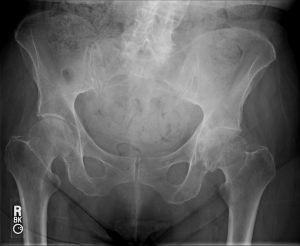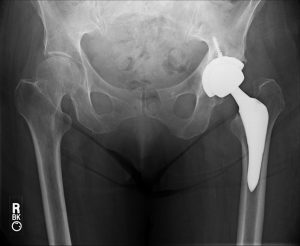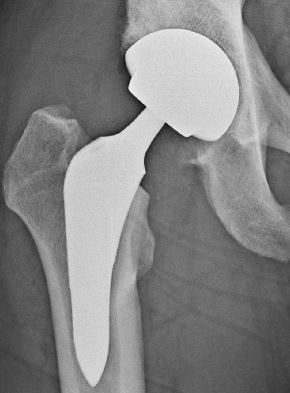Direct Anterior Total Hip
Background
The hip is a ball and socket joint comprised of the femoral head (ball) and the acetabulum of the pelvis (socket). This joint is prone to high levels of stress, bearing the most weight of any other joint, secondary to the knee. The femoral head is attached to the pelvis via a fibrous synovial lined joint capsule. Additional stability and function is provided by multiple surrounding ligaments, tendons and muscles. Overlying the femoral head and lining the acetabulum is a smooth and tough covering of hyaline cartilage. This cartilage is important in providing protection to the bony surfaces of the hip joint and allowing for a smooth pain free range of motion. If either of the cartilage surfaces degenerates over time, pain can occur. This degenerative process is multi-factorial in its cause and includes both modifiable and non-modifiable risk factors.
Some modifiable risk factors include prior trauma involving the articular surfaces of the joint, obesity, muscle weakness, and chronic heavy loading of the joint. Non-modifiable risk factors include gender (females > males), age, genetics and developmental hip abnormalities (dysplasia, Legg-Calve-Perthes disease, slipped capital femoral epiphysis).

L hip showing osteoarthritis prior to hip replacement.

Left Total Hip Replacement
Diagnosis
The diagnosis of hip arthritis can usually be obtained through a detailed history, physical exam and X-rays. The patient’s history may include symptoms of groin pain, pain “deep in the joint”, pain in a “c-clamp” distribution around the hip, thigh and even occasional knee pain. Physical exam may show limitations in range of motion and certain provocative measures can elicit pain in the groin. X-rays will show decreased joint space and even surrounding osteophytes from the femoral head or acetabular rim. On occasion, an MRI may be needed to confirm cartilage degeneration.
Treatment
In the early arthritic hip, treatment may initially consist of avoidance of aggravating factors and over the counter medications such as acetaminophen and/or NSAIDs. As the osteoarthritis worsens, intra-articular steroid injections may be offered. These injections can be performed in our office under ultrasound guidance, avoiding the need to have this done under X-ray at a hospital. As a result, the cost is much less and the outcome is just as effective. When conservative measures are no longer providing adequate pain relief, the surgical option of total hip replacement may be explored.
There are a few different methods and approaches when performing a total hip replacement. Much of the differences lie in the manner in which the hip joint is accessed. Generally speaking, the three approaches are the anterior, anterior-lateral, and posterior approaches. Although more technically demanding, the direct anterior approach is chosen by Dr. Lee for several reasons. For example, in a direct anterior approach, the muscles around the hip are merely moved out of the way during the surgery. No glute tendons are cut as with a posterior approach. Hip retractors are carefully placed to provide adequate visualization. As a result, no subsequent tendon repair is required, thus, alleviating the need for protecting a repair.
With a posterior approach, tendons around the hip must be cut and pulled out of the way in order to access the joint. These tendons are subsequently repaired but require several months of rehabilitation and healing time. Also, the posterior capsule of the hip joint must be opened to access the hip which puts the patient at increased risk for posterior hip dislocations. Therefore, after a posterior total hip, the patient requires several range of motion limitations including avoidance of deep hip flexion and crossing your legs. Therapy is also required to strengthen the surrounding muscles which can take around 3 months before the hip precautions are removed.
Preoperative Care
Exercise/activity
Before your surgery we suggest that if you are healthy enough, you should begin or continue with an exercise program. This can be initiated through a physical therapy clinic or through a home-exercise program. Walking daily is an easy way to get some physical activity prior to surgery. The more you are able to do before surgery, the better off you will be following surgery. A therapist will be able to perform a functional assessment and identify any preoperative impairments.
Preoperative Risk Assessment
You will be asked to see your primary care provider prior to your surgery. This is sometimes referred to as preoperative clearance. This is a necessary step to ensure that you are healthy enough to withstand the stress of surgery. This step is often facilitated by our surgery scheduler and is usually done within 30 days of your anticipated surgery. Sometimes other health problems are discovered and you may need further evaluation by specialists prior to having your surgery scheduled.
Infection Prevention
You may or may not be given a preoperative surgical soap to use over the3 day period before surgery. If you have a history of severe infection or MRSA please make sure the surgeon or physician assistant is aware of this prior to surgery as it may be necessary to take additional steps to help prevent a postoperative infection.
Scheduling
The surgical facility will contact you and review your medical history, medications, and allergies 3-5 days prior to surgery. They will confirm your arrival time and make sure that you understand where to go on your day of surgery.
Eating and Drinking
It is imperative that you DO NOT EAT OR DRINK ANYTHING AFTER MIDNIGHT PRIOR TO YOUR SURGERY. Even if you have a case scheduled later in the day, sometimes our surgical teams will run ahead of schedule and you will be called to come to the surgical facility early, if you have eaten since midnight this will delay your surgical starting time by up to 8 hours after the time you last ate or drank.
Day of Surgery
Arrival
You will need to arrive at the facility at least 90 minutes prior to your scheduled procedure. Sometimes you will require additional blood and urine testing prior to your surgery. Leave all valuables at home and wear comfortable clothes and bring comfortable clothing for after surgery.
Preparation For Surgery
You will be asked to change into a surgical or hospital gown and the nursing staff will start an IV and begin giving you fluids through the IV. Staff will ask you many questions about your health, your medications, and your allergies. It is important that you answer their questions truthfully and as completely as you can. This is important for your health and safety during and after surgery. You may be asked to clean the surgical site once more with a skin cleansing wipe and mark the area with a surgical marker.
Anesthesia
You will meet and visit with your anesthesia provider prior to your surgery. They will discuss your medical history, any anesthesia concerns, and different anesthesia options including regional blocks, spinal anesthesia, and general anesthesia.
Surgical Consent
You will meet with your surgeon one more time before surgery. This is an opportunity to ask any final questions, clarify the procedure, and to discuss the risks and benefits of surgery one more time before getting started. The surgeon will sign your operative site. If you have questions or concerns please talk to your surgeon about these at this time.
After Surgery
Recovery

After Hip Replacement
You will be taken to the recovery room after surgery. Your doctor will speak to your family and explain how the procedure went. You will stay in the recovery room for approximately 1 hour and then transferred to your room. During this time and throughout your hospital stay you need to communicate with your nurse and let them know if you are having pain or other problems. You need to let them know if the medications they are using are working to adequately control your pain. You need to let someone know immediately if you are experiencing nausea, chest pain, shortness of breath, or any other issues.
Antibiotics/infection prevention:
You will receive IV antibiotics for 24 hours after your surgery. Usually, antibiotics are not required after that 24 hour period. Urinary catheters (if placed) will be removed on postoperative day 1 after your surgery to prevent a bladder or other urinary tract infection. Drains (if placed) will likely be removed on postoperative day 1 and your dressing will be changed on postoperative day 2 or sooner if necessary.
Blood Clot Prevention
During your hospital stay you will be given injections to prevent blood clots. At discharge you will be instructed to take 325mg of aspirin twice a day for a period of time (3-6 weeks) to help prevent blood clot formation. If you have a history of blood clots, pulmonary embolism (blood clot in the lungs), or other blood clotting disorder you may need to take a prescription blood thinner (such as Coumadin, Xarelto, or similar medication) and you may require weekly monitoring of your blood.
Physical Therapy
Physical therapy will begin as early as the day of your surgery but most often on postoperative day 1. This is where the real work of your recovery begins. You will be instructed on the use of crutches, walkers, wheelchairs or other devices to help you get moving. You will be instructed on how much weight you can place on your operative limb. You will have to achieve certain goals prior to being discharged from the hospital. This is to ensure that your are safe and have the strength to return home.
You must be able to:
- Stand at the edge of the bed
- Walk 100 ft in the hallway
- Safely get to and use the bathroom
- Transfer out of the bed to a chair or to the bathroom
- Ascend and descend stairs safely
Going Home
Pain Management
You will be given pain medications at the time of discharge. These may include narcotic medications.
Physical Therapy
You may need to follow up with a physical therapy office after your discharge from the hospital to continue your rehabilitation.
Postoperative Activity
It is important to remain active after surgery. You should be getting up several times during the day to walk and exercise. We recommend continuing to use ice to help prevent pain and swelling. You may require a front wheeled walker or other assistive device for the first 10 days and then transition to a cane or walking stick.
Follow Up
You will return to the office in 10-14 days for staple/suture removal and to evaluate your progress with rehabilitation. You might have x-rays taken at that time to evaluate the placement of your hardware. You will have regular x-rays over the next several months to keep track of how your hip is healing.
The staff at Big Horn Basin Bone and Joint will be available if any issues or concerns arise during the course of your care. All questions are welcomed and we will do our best to address any issues or questions in a timely manner. We highly recommend signing up for the portal system through our electronic medical record. This is a safe-secure and efficient way to communicate with your Doctor, PA, and our staff. Our number one concern is helping you to recover and regain your quality-of-life.
